
Buddhism, a profound spiritual tradition dating back centuries, offers guidance to millions seeking enlightenment. For individuals rooted in Indian culture and tradition, exploring Buddhism’s core principles provides valuable insights into life’s spiritual aspects. This article aims to simplify the fundamental beliefs of Buddhism, making them accessible to beginners and those seeking a deeper understanding.
Origins and Development
The Life of Siddhartha Gautama
Buddhism originated with Siddhartha Gautama, the Buddha, in the 5th century BCE. Born into royalty in present-day Nepal, he abandoned his privileged life to seek the truth about suffering. Through intense meditation and self-discipline, he achieved enlightenment under the Bodhi tree in Bodh Gaya, India. This pivotal moment marked the beginning of Buddhism.
Evolution of Buddhist Schools
Over time, Buddha’s teachings evolved into distinct schools, each with its own emphasis:
- Theravada Buddhism: This school adheres to the earliest teachings and emphasizes monastic life and personal liberation through meditation and mindfulness.
- Mahayana Buddhism: Centered on compassion and the Bodhisattva ideal, Mahayana emphasizes the potential for all beings to attain enlightenment and the importance of helping others on their path.
- Vajrayana Buddhism: This school incorporates esoteric practices, rituals, and tantric techniques to accelerate the path to enlightenment.
Buddhism’s Expansion Across Asia
Buddhism spread from India across Asia, influencing various cultures while retaining its core principles. King Ashoka’s conversion to Buddhism in the 3rd century BCE played a crucial role in its widespread propagation, as he actively supported its dissemination throughout his empire and beyond.
The Four Noble Truths
Central to Buddhist philosophy are the Four Noble Truths, which address the nature of suffering and the path to liberation:
- Dukkha (Suffering): Acknowledges that life inherently involves suffering, from physical pain to emotional distress.
- Samudaya (Origin of Suffering): Identifies craving, attachment, and ignorance as the root causes of suffering.
- Nirodha (Cessation of Suffering): Asserts that it is possible to end suffering by eliminating craving and attachment.
- Magga (Path to the Cessation of Suffering): This is the Noble Eightfold Path, which outlines the practical steps to achieve liberation from suffering.
The Noble Eightfold Path
The Noble Eightfold Path provides a framework for ethical conduct, mental discipline, and wisdom:
- Right Understanding: Developing a correct understanding of Buddhist teachings, particularly the Four Noble Truths. This involves studying the Dharma and reflecting on its meaning.
- Right Thought: Cultivating thoughts of loving-kindness, compassion, and non-violence. This involves abandoning negative thoughts such as greed, hatred, and delusion.
- Right Speech: Speaking truthfully, kindly, and avoiding gossip or harsh language. This promotes harmonious communication and prevents misunderstandings.
- Right Action: Acting ethically and morally, refraining from harming others, stealing, or engaging in harmful behaviors. This creates a foundation of integrity and respect.
- Right Livelihood: Earning a living in a way that does not harm others or contribute to suffering. This might involve choosing a profession that aligns with Buddhist values.
- Right Effort: Making an effort to cultivate wholesome qualities and abandon unwholesome ones. This requires consistent practice and self-reflection.
- Right Mindfulness: Paying attention to the present moment without judgment, observing thoughts, feelings, and sensations as they arise. This cultivates awareness and reduces reactivity.
- Right Concentration: Developing focused attention through meditation, which leads to deeper states of tranquility and insight. This enhances mental clarity and stability.
Karma and Rebirth
Karma: The Law of Cause and Effect
Karma, a fundamental concept in Buddhism, emphasizes that actions have consequences. Positive actions create positive karma, leading to favorable outcomes, while negative actions generate negative karma, resulting in suffering. Intention plays a key role in determining the karmic impact of an action.
Samsara: The Cycle of Rebirth
Samsara refers to the continuous cycle of birth, death, and rebirth, governed by karma. The quality of one’s actions in this life influences future lives. The ultimate goal is to break free from this cycle and achieve Nirvana, a state of liberation from suffering.
Meditation and Mindfulness
Meditation Techniques
Meditation is central to Buddhist practice, cultivating mindfulness, concentration, and insight. Different types of meditation exist, including Samatha-vipassana, which combines calming the mind (Samatha) with developing insight into the nature of reality (Vipassana).
Mindfulness in Daily Life
Mindfulness involves being present in the moment without judgment. It can be integrated into daily activities like eating, walking, or simply breathing. Regular mindfulness practice reduces stress, enhances emotional regulation, and fosters a deeper connection with oneself and the world.
Buddhist Ethics and Morality
The Five Precepts
Buddhist ethics are based on the Five Precepts, moral guidelines for lay practitioners:
- Refrain from taking life.
- Refrain from stealing.
- Refrain from sexual misconduct.
- Refrain from lying or harmful speech.
- Refrain from intoxicants that cloud the mind.
Compassion and Loving-Kindness
Compassion (Karuna) and loving-kindness (Metta) are central to Buddhist ethics, promoting harmonious relationships and reducing suffering.
Buddhist Rituals and Practices
Buddhist rituals and practices support spiritual development and connection to the teachings:
- Taking Refuge: Formally expressing commitment to the Buddha, the Dharma (teachings), and the Sangha (community).
- Chanting and Recitation: Repeating mantras or sutras to cultivate mindfulness and connect with Buddhist teachings.
- Pilgrimage: Visiting sacred sites associated with the Buddha’s life to deepen one’s practice and understanding. Planning Your Spiritual Retreat: An Ashram Stay Guide
Poojn.in: Supporting Your Buddhist Journey
Poojn.in offers a wide selection of products to support your Buddhist practice, including:
- Bel malas (bead garlands): Used for counting mantras during meditation or prayer, available in various materials like wood or seeds.
- Statues and images of Buddha: Serve as focal points for meditation and reminders of Buddhist principles, available in various sizes and materials.
- Incense and candles: Create a calming atmosphere for meditation and ritual practices, available in various scents and forms. These can enhance the sensory experience of your practice.
Conclusion
Buddhism’s core teachings offer a path to inner peace, ethical living, and spiritual awakening. By understanding concepts like the Four Noble Truths, the Eightfold Path, and the principles of karma and rebirth, individuals can embark on a transformative journey toward enlightenment.


